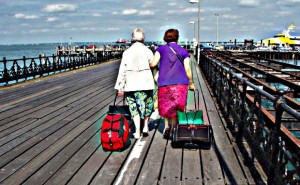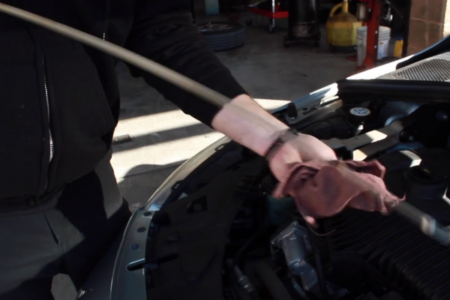 For the tenth day in a row ? or the twentieth, or thirtieth ? you wake up and the sky looks like death leaking out of a giant, overturned bowl. That putrid gray haze could be eight in the morning, or three in the afternoon. Same difference, you think, like the day doesn’t even matter. Oh really, you?re fine. You?re not coming down with something; you?re just down. Waiting for something to ease the sense of hopelessness, the lack of energy, the difficulty waking up, the difficulty completing basic tasks. You don?t even know you?re experiencing the first major symptoms of seasonal affective disorder, more commonly known as SAD.
For the tenth day in a row ? or the twentieth, or thirtieth ? you wake up and the sky looks like death leaking out of a giant, overturned bowl. That putrid gray haze could be eight in the morning, or three in the afternoon. Same difference, you think, like the day doesn’t even matter. Oh really, you?re fine. You?re not coming down with something; you?re just down. Waiting for something to ease the sense of hopelessness, the lack of energy, the difficulty waking up, the difficulty completing basic tasks. You don?t even know you?re experiencing the first major symptoms of seasonal affective disorder, more commonly known as SAD.
SAD has been linked to a biochemical imbalance in the brain prompted by shorter daylight hours and a lack of sunlight in winter ? with or without an accompanying plunge in temperature. According to the American Osteopathic Association, SAD can affect up to 10% of Americans per year. Many cases go undiagnosed, showing all the signs of clinical depression: lethargy, hopelessness, suicidal thoughts, lack of interest in normal activities, and social withdrawal. Many go on an antidepressant medication they won?t need come April or May ? and if they decide to go off then, they suffer uncomfortable withdrawal symptoms that numb the joy of one of the best times of year. So is there a more natural and equally effective way to treat SAD?
Although it may seem hard to believe, there are countless places out there, right now, where there isn?t a cloud in the sky, and day outlasts night. You only need to get there ? or to the nearest airport. Think of your trip as recharging your batteries. A two-week trip can revitalize you for a full season the same way an early-morning three-mile jog can give you an invigorating dose of energy for the next fourteen hours of your day. In fact, the biggest hurdle you may need to overcome to take ?the SAD journey? is to make your plans and follow through with them. Here are some recommendations.
Explain to others why you need to get away. Don’t take any flack from neighbors, friends, and coworkers who believe in ?sticking out? a miserable winter and view you as self-indulgent for going hundreds or thousands of miles south before you?ve even cracked your rubber boots. There are a lot of people who relocate, temporarily or permanently, for health reasons. We?re not all fortunate enough to live in the environment that?s ideal for us, and you?re going to be of far more value to others as a person, a professional, and a loved one if you take care of yourself than if you wrap yourself into a depressive ball until the spring equinox.
Don’t go alone ? but don’t take your whole family either. A lot of people don’t travel to relieve their SAD symptoms because they recognize the impracticalities of taking a trip in the middle of “off-season,” when kids are back in school, their spouse may have difficulty getting time off, and elderly parents don?t want to be pulled away from their perch next to the fire with a good book. Feeling a bit selfish or oversensitive just looking at any of them? You shouldn?t ? in fact, you should take a closer look at the people you care about. SAD is prevalent enough that the chances are a family member or good friend also has SAD, or displays some early warning signs. Since SAD is known to be hereditary, and to occur more in women than men, your daughter, niece, or granddaughter could be suffering from SAD ? but has been labeled with a ?mood problem.? Look for the same symptoms in them that you noticed in yourself, and invite a fellow SAD sufferer to travel with you. Not only will they greatly benefit from the trip, but you?ll be showing them the importance of managing a health problem early on.
Have a plan to manage jet lag. If you?re journeying a long distance southwest or southeast, the last thing you want is to be so affected by the time difference that you’re awake half the night and sleepy when the sun is streaming through your hotel windows. Over-the-counter melatonin supplements can help you adjust, as can modifying your sleep schedule days before you leave in order to ease the transition to a different time zone. Ask your doctor for some suggestions based on where you’re going.
Don’t run yourself ragged at your destination. Given the expense and personal resources devoted to a trip, many people try to cram in as many activities as possible to get the most ?worth? out of their travels. Recognize that it?s not what you do, but how you do it that will make you feel better ? and that by steering clear of tour buses, you avoid getting pulled into a museum or two that defeat the purpose of your journey. Focus on simple outdoor activities ? things that keep you moving instead of thinking. And once you?re tired, don?t feel bad about sitting out on the beach or deck for hours ? just don?t forget the sunscreen.
Look on the brighter side (literally) when you return home. Remember, you can expect the positive physiological effects of your trip to last for many weeks to come. It might still be snowing or raining all day when you get home, but the days will already be getting longer ? and the dreary surroundings won?t feel so permanent. SAD, unlike a flu bug, needs several weeks to fester in place, and you have time on your side. Pretty soon your home will have that glow that reminds you of vacation ? and you?ll only need to journey to your nearest window to enjoy it.
Rita Anya Nara suffered from panic disorder, seasonal affective disorder, and social anxiety disorder when she started traveling and wrote her book, The Anxious Traveler, from her own experiences. She hopes to inspire those too afraid to travel to manage their fear while having an incredible life experience. Nara is an avid photographer, loves to hike, and is studying to be a professional travel companion. She resides in northern California when she?s not traveling.
For further information on the book and the author, please visit www.thebravetraveler.com.
The Anxious Traveler is available for purchase on www.amazon.com and www.barnesandnoble.com.





